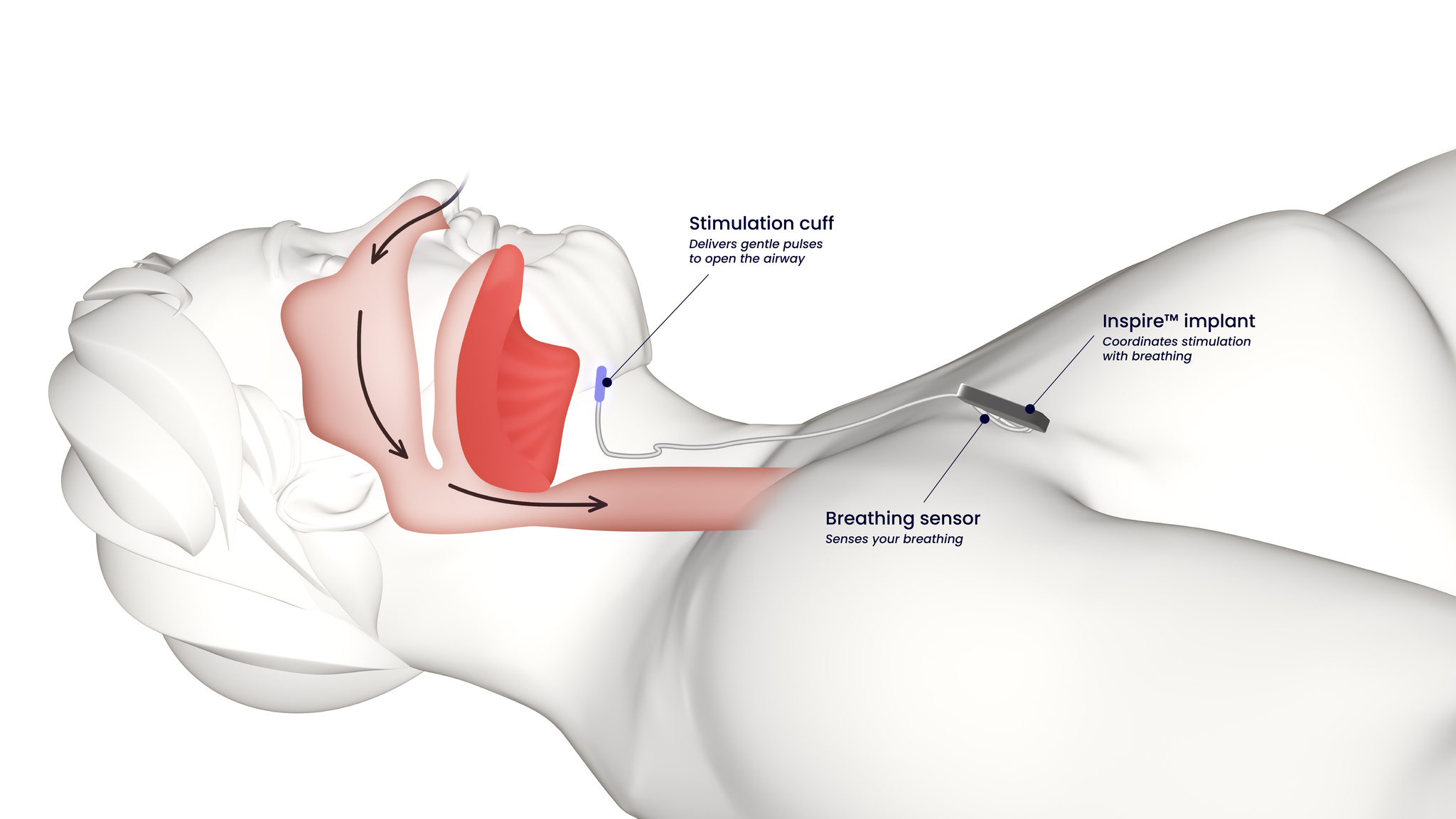Inspire Therapy for Sleep Apnea
Sleep apnea is a chronic condition that affects your breathing during sleep, where it repeatedly stops and starts. You might be familiar with the most common treatment: continuous positive airway pressure (CPAP) therapy. However, you might not have found relief or have struggled with its continuous use. For individuals like you seeking an alternative, the Inspire procedure offers a different approach to managing obstructive sleep apnea (OSA).
The Inspire Procedure
Pre-Operative Considerations
Before considering the Inspire procedure, you must undergo a thorough medical evaluation to ensure you’re a suitable candidate. This typically includes:
Sleep Study: An overnight examination to assess the severity of your OSA.
Physical Examination: An evaluation of your airway anatomy and overall health.
Medical History Review: An analysis of past treatments and your body’s response to them.
Surgical Procedure

Device Implantation: A small generator is implanted under the skin in your upper chest.
Sensing Lead: A lead is positioned between your rib muscles to detect your natural breathing pattern.
Stimulation Lead: Another lead is attached to the hypoglossal nerve, which controls tongue movement.

Post-Operative Care
Post-surgery, you will have a recovery period where activities may be limited to ensure proper healing. The care plan typically includes:
Follow-up Visits: To monitor the healing process and device function.
Activation: The device is usually activated 4-6 weeks after surgery to allow for healing.
Adjustments: Subsequent adjustments to the device settings are made to optimize therapy efficacy.
You’ll also receive detailed instructions on how to use the remote control to turn the device on before sleep and off upon wa
How Inspire Treatment Works

The Inspire system is composed of a stimulation lead coupled with a breathing sensor, both of which are energized by a diminutive battery. The entire mechanism is surgically implanted beneath the skin in the region of the neck and chest via two or three minimal incisions. This is an outpatient procedure, typically allowing patients to return home on the same day and manage any discomfort with over-the-counter pain relief if necessary.
The effectiveness and safety profile of the Inspire system were rigorously evaluated during the STAR clinical trial. The one-year results of the STAR trial were disclosed in the January 9, 2014, issue of the New England Journal of Medicine. The findings revealed that patients utilizing Inspire experienced notable decreases in sleep apnea episodes and substantial enhancements in quality of life metrics. These positive outcomes were maintained throughout a five-year follow-up duration. To date, Inspire therapy has been the subject of over 150 peer-reviewed articles.
Effectiveness and Outcomes
The Inspire Procedure has demonstrated notable efficacy in treating obstructive sleep apnea (OSA), with various clinical studies supporting its success. You can evaluate the procedure’s effectiveness by reviewing clinical data, success rates, and first-hand experiences.
Clinical Studies
Clinical trials have played a crucial role in establishing the Inspire Procedure’s effectiveness. Research indicates that the majority of patients experience a significant reduction in their Apnea-Hypopnea Index (AHI), which measures the severity of sleep apnea.
Study Results: One pivotal study published in the Journal of Sleep Medicine found a 78% decrease in AHI scores among participants after one year of Inspire therapy.
Success Rates
The success of the Inspire Procedure is often quantified through success rates, which reflect the percentage of patients who achieve a specified reduction in AHI or subjective improvement in sleep quality.
Objective Success: The American Academy of Sleep Medicine considers a treatment successful if it results in a greater than 50% reduction in AHI or an AHI falling below 20, both of which are often met with Inspire therapy.
Subjective Success: Patient reported improvements in quality of life and daytime sleepiness are also significant indicators of success.
Patient Testimonials
Patient anecdotes complement clinical data by offering personal insights into the efficacy of the Inspire Procedure.
Improvement in Daily Life: Many patients report improved sleep quality, more energy during the day and decreased snoring.
Overall Satisfaction: Satisfaction rates are high, with patients appreciating the minimally invasive nature of the therapy and the ease of use.
Comparison With Other Treatments
When considering the Inspire Procedure to manage sleep apnea, you have several alternative treatments available. It’s important to understand how each treatment functions and differs to make an informed decision.
CPAP Therapy
Continuous Positive Airway Pressure (CPAP) therapy is a commonly prescribed treatment for obstructive sleep apnea. It involves wearing a mask that delivers continuous air pressure to keep your airways open during sleep.
Ease of Use: CPAP devices require nightly use and some users find the masks uncomfortable.
Effectiveness: Highly effective when used consistently and correctly.
Oral Appliances
Oral appliances are custom-fitted devices that you wear in your mouth while you sleep. They position the jaw forward to maintain an open upper airway.
Comfort: Generally considered more comfortable and less intrusive than CPAP masks.
Suitability: Better suited for mild to moderate obstructive sleep apnea.
Surgical Alternatives
Various surgical options, including Uvulopalatopharyngoplasty (UPPP) and jaw advancement surgeries, aim to permanently remove or reposition tissue obstructing the airway.
Invasiveness: These procedures are more invasive with longer recovery times than CPAP therapy or oral appliances.
Long-term Solutions: Can offer a permanent solution, but with variable success rates.
Insurance and Cost Considerations
When considering the Inspire Procedure for Sleep Apnea, you’ll need to examine your insurance coverage and understand how the costs compare to other treatments.
Insurance Coverage
Your insurance may cover the Inspire Procedure, but this varies by carrier and individual policy. It’s essential to:
Contact your insurance provider to confirm if the Inspire Procedure is a covered benefit.
Understand your policy specifics, such as deductible, co-pay, and co-insurance rates.
Health insurance coverage for Inspire Therapy, a treatment for obstructive sleep apnea (OSA), can vary by provider and individual policy. Medicare does cover the Inspire procedure for eligible patients who meet specific criteria, such as having moderate to severe OSA and being unable to use or get consistent benefit from Continuous Positive Airway Pressure (CPAP) therapy. However, prior authorization may be required, and patients typically need to undergo a sleep study and other assessments to confirm eligibility. It’s important for individuals to check with their own insurance provider to understand their coverage, as private insurers may have different policies regarding the Inspire Therapy.
Cost Comparison
Comparing costs between the Inspire Procedure and other sleep apnea treatments is crucial for your financial planning. Here’s what to consider:
Initial expenses for the Inspire Procedure can be high, but compare this to the long-term costs of CPAP machines, including replacement parts and electricity.
Consider the value of improved quality of life when weighing costs, as some patients find the upfront investment to be justified.
Managing Life With Inspire
Adapting to the Inspire therapy for sleep apnea involves certain lifestyle adjustments and understanding long-term considerations. Noting these changes will help you integrate the therapy effectively into your daily life.
Lifestyle Adjustments
Daily Usage: Initiate Inspire therapy by activating the device with the handheld remote before bedtime. Press the same button upon waking to deactivate the device.
Activity Restrictions: Post-implantation, avoid high-contact activities for a prescribed period to ensure proper healing. Follow your healthcare provider’s advice to determine when you can resume full activity.
Long-Term Considerations
Maintenance: Regularly check the Inspire device, and replace the remote’s battery as needed. Schedule annual check-ups with your doctor to assess device function.
Battery Life: The Inspire implant’s battery life is typically around 11 years. Plan for a replacement procedure when the time approaches, as indicated by your healthcare provider’s guidance.
Frequently Asked Questions
Inspire Therapy is an FDA-approved obstructive sleep apnea treatment. It involves a surgically implanted device that stimulates certain muscles to keep your airway open during sleep.
The Inspire system consists of a breathing sensor and a stimulation lead, powered by a small battery. When you sleep, the sensor detects your breathing patterns and signals the lead to stimulate the airway muscles, allowing you to breathe normally.
Inspire Therapy is minimally invasive and involves a surgical procedure usually performed under general anesthesia.
Candidates for Inspire are typically those with moderate to severe obstructive sleep apnea who have not found relief from CPAP (Continuous Positive Airway Pressure) therapy.
All surgeries carry risks. Potential risks specific to Inspire include discomfort, infection, or device malfunction. Your doctor can provide a comprehensive list of risks.
The Inspire battery lasts about 11 years and can be replaced in a simple outpatient procedure.
Health insurance coverage for Inspire Therapy, a treatment for obstructive sleep apnea, varies by provider and policy. Medicare covers this for eligible patients with moderate to severe OSA who can’t benefit from CPAP. Prior authorization and assessments are usually needed. Check with your insurer to know your coverage, as policies differ among providers.








 Make an Appointment
Make an Appointment